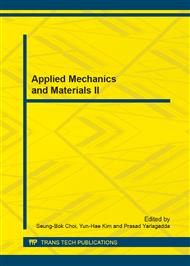p.3
p.7
p.14
p.21
p.25
p.30
p.34
p.39
Analysis of Plastic Strain between Substrate and Micro-Cantilever under Different Deformation Characteristics
Abstract:
The contact between substrate and micro-cantilever simplified as an ideal flat substrate contact with a micro-cantilever rough surface. A three-dimensional adhesive contact model was established on isotropic rough surfaces exhibiting fractal behavior, and the equivalent plastic strain was discussed using the finite element analysis. The maximum equivalent plastic strain and its depth were presented with the different paths of rough solid when loading. The result show that the equivalent plastic strain versus different depth which at different locations showed different laws, in the top area of the asperities versus different depth, the maximum equivalent plastic strain occurs in the subsurface range about 0.5μm from the surface or on the surface. In addition, with different deformation characteristics, the degree of the equivalent plastic strain was different.. The contact model between micro-cantilever rough surface and flat substrate will lay a foundation to further research on the substance of the process of friction and wear.
Info:
Periodical:
Pages:
21-24
Citation:
Online since:
December 2013
Authors:
Price:
Сopyright:
© 2014 Trans Tech Publications Ltd. All Rights Reserved
Share:
Citation:


